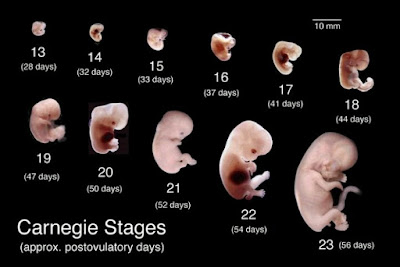Once the blastocyst implants in the uterine wall, it
splits into two sets of cells, one of which will become the placenta and one
the embryo/fetus. The placenta sends
hormone signals to the woman’s body that it is pregnant. On Day 14 the zygote stage ends and the
embryo stage begins. This stage is when
cell differentiation into different organs begins. The first step, known as
grastrulation sees the embryo form three germ layers from which all the tissues
will be formed. By Day 20 there is the beginning development of brain, heart,
spinal cord and gastro intestinal tract. The embryo is the size of an apple
seed or a grain of rice*.
 |
Human fetus at about 4 weeks.
Adapted from www.invitra.com/two-months-pregnant/
|
 |
At the end of 30 days, the embryo is about the size of a
raspberry, some 10,000 times larger than the original fertilized egg. At 8 weeks, the embryo is about 25 mm and weighs
10 grams; by 13 weeks, the end of the first trimester, it is perhaps 80 to 100
mm and 28 grams.
At the end of 26 weeks or the second trimester, the fetus
could be born and survive with proper
care, developing into a healthy baby. The third trimester is primarily about the growing
and maturing fetus. So far, I have described what we can see and measure
in the developing fetus from conception on.
What is not as well-known as it is more difficult to measure is the development
of the non-physical. If birth after 26
weeks is viable then these must be in place by then also.
The bottom line is that the process is extremely complex and
it is a wonder that any of us turn out “normal” in the statistical sense of “what
usually happens”. (It is also normal ie it usually happens, that one in 800
births is a Down Syndrome baby). So many things from both internal and external
sources can affect fetal development. Alcohol;
drugs, licit and illicit. It may not take much and timing is sometimes everything. If 45 grams of a certain plant are fed twice
daily for three to a pregnant sheep beginning on day 29 of pregnancy, the lamb
will be stillborn with one huge eye in the middle of its forehead. If a heifer calf is born twin to a bull, the male
hormones over power the female hormones and the female is born sterile.
You can reach your own conclusions to this story but
at least now you have a better idea of how things work.
*For a good overview of fetal
development from conception through birth, see
there are two parts to it? My only focus was always the first.
ReplyDeletethe Ol'Buzzard
There is a third part when I get it written, that makes the first part possible
DeleteIt is an amazing process in nearly every species and always raises more questions than answers.
ReplyDeleteNo kidding. Part 3 will deal with some of those questions when I get it written
DeleteProf. Prem raj Pushpakaran writes -- 2025 marks the birth centenary year of Robert G. Edwards, and let us celebrate the occasion!!! https://worldarchitecture.org/profiles/gfhvm/prof-prem-raj-pushpakaran-profile-page.html
ReplyDelete